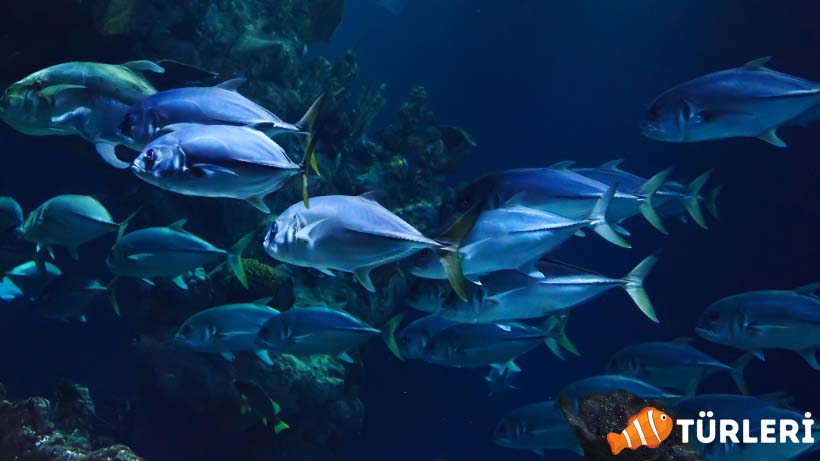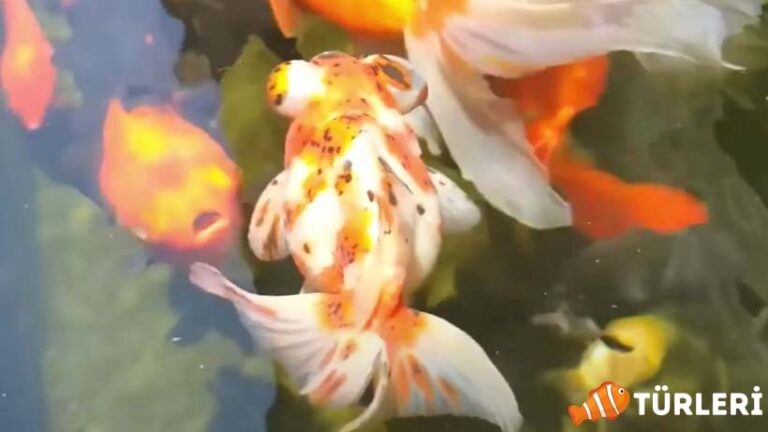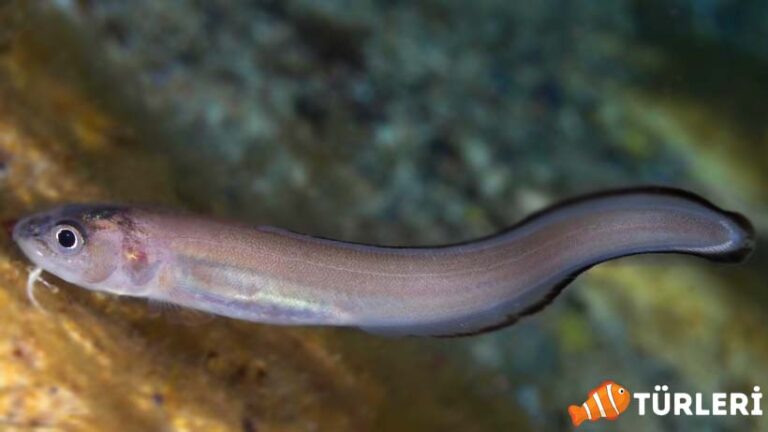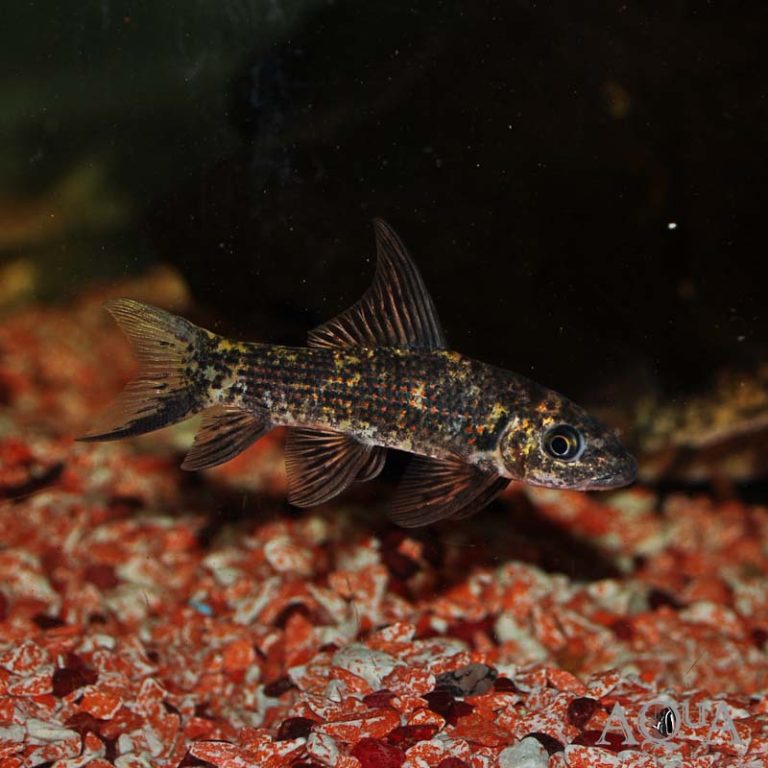List of Aegean Fish: 38 Different Fish Species
In our list of Aegean fish, we will talk about 38 specific and commonly found fish species native to the Aegean Sea. Thanks to its warm summers and mild winters, our Aegean Sea is home to many different types of fish.
With this guide, you will be able to learn about species among the Aegean sea fish that you’ve never heard of and would want to know more about. Let’s dive into our illustrated list of Aegean fish, which includes both poisonous and edible species!
1. Leerfish
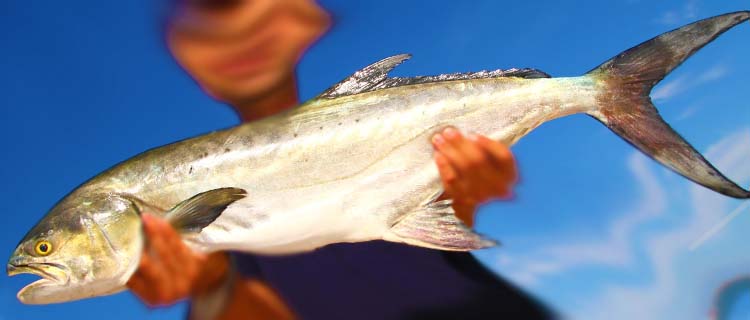
The bluefish, a member of the Carangidae family, is one of the sea fish that excites anglers the most when hunting, due to its size and thrilling chase. This species, known as bluefish, is also referred to as “liça” in some regions.
The maximum adult size is 200 cm in length and 50 kg in weight. However, those found in the Aegean Sea are generally observed to grow up to around 120 cm.
During their breeding season between May and August, they gather strength by eating mullets and sardines as they travel to river confluences to spawn. Their primary food is mullet fry.
While smaller bluefish are found near river mouths, the larger ones live in depths of 40-50 meters and in areas not too far from the shore.
2. Lionfish
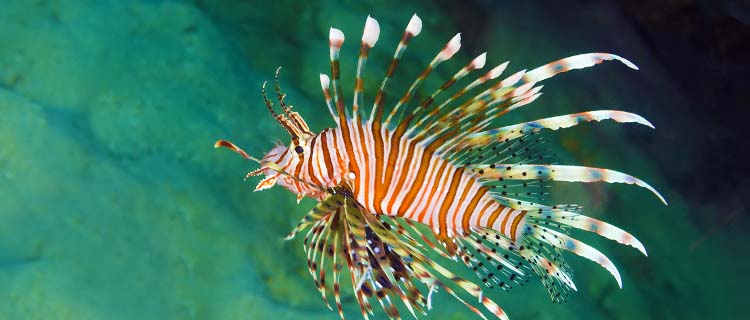
This species, a variant of lionfish native to the Indo-Pacific region, is scientifically named Pterois miles. Due to their similarities, they are often confused with the red lionfish.
In addition to the Indo-Pacific region, they are known to inhabit the waters of our country, particularly in the Aegean Sea. Like the general species of lionfish, this species is also venomous.
It has a total of 13 spines on its back. Their colors range from red, grey, or flesh-toned shades. They hunt during the night, making them not very active during the day. They feed on small crustaceans and fish.
Adult sizes can reach up to 35 cm. Although they are among the fishes of the Aegean Sea, they are commonly seen in the waters of the Red Sea and Indonesia.
3. Mullus barbatus
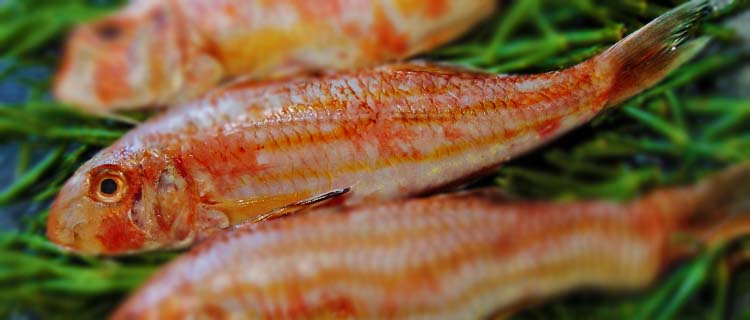
While its official name is the “red mullet” fish, it is commonly known as “Barbun” among the locals. This species belongs to the Mullidae family and its scientific name is Mullus barbatus.
They inhabit warm and temperate waters like the Aegean Sea, particularly in shallow sandy and muddy areas close to the shore. They are occasionally spotted in rocky areas as well. They are known for their resemblance to the Striped red mullet. To distinguish between the two, one should observe the nose, the area below the eyes, and the dorsal fin.
Their maximum size can reach 40 cm, but those in the Aegean Sea region are typically around 18-20 cm. They are of commercial significance among Aegean fish and are known for their tasty flesh.
4. Gilt-head bream
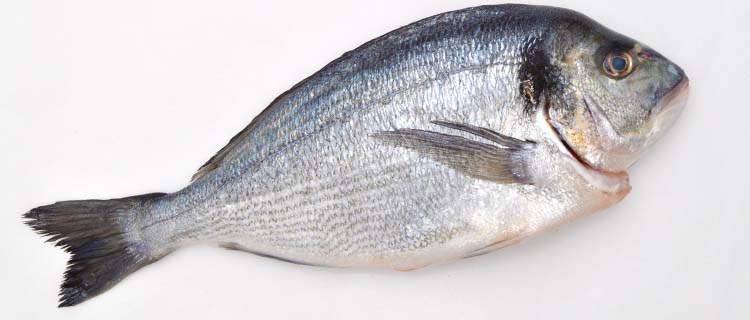
The Sea Bream, also known as “Çupra,” is among the fish species of the Aegean Sea, but they also live in the Mediterranean region.
They inhabit areas with temperate waters, primarily in sandy and muddy regions. They can occasionally be found in river estuaries and lagoons.
Those weighing 200 grams and above are named Çipura, while those below this weight are called Lidaki. They have a powerful jaw, which enables them to easily consume crustaceans.
If one wishes to catch them, they can be found near the shores during the summer months and at depths of 30-40 meters during the winter. Larger Sea Breams tend to go deeper during the winter. They are of high commercial value and are among the delicious fishes of the Aegean Sea.
5. Salema porgy
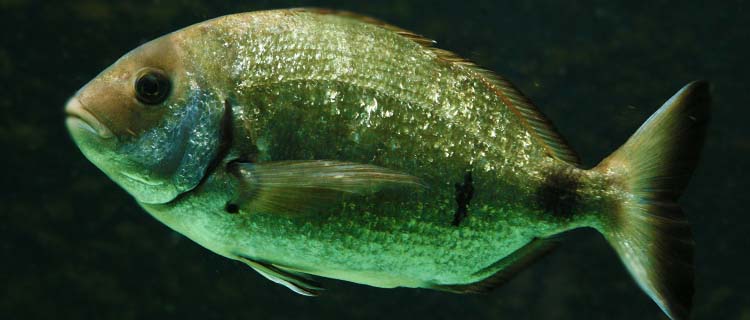
They closely resemble the Sea Bream in appearance. They are commonly known as “Sarpa fish” among the people. They have habitats ranging from the surface down to a depth of 70 meters.
Their upper parts are a bluish-gray color, and their sides are silver-colored. The maximum recorded length is 51 cm, but they are typically seen in the range of 15-30 cm.
Among the fish species of the Aegean Sea, they have no commercial value. Although it hasn’t been precisely determined through research, it’s believed that due to an algae consumed by the fish, eating Sarpa can lead to a condition known as hallucinogenic fish intoxication in humans.
6. Painted comber

The Painted Comber, also known as “Hani fish,” belongs to the Serranidae family, which also includes the Grouper, and is from the Serraninae subfamily, which encompasses the Sea Bass. Its scientific name is Serranus scriba. The Striped Hani fish is among the fish species of the Aegean Sea, but Hani fish in general are commonly found in the Mediterranean and the Black Sea.
The Striped Hani, specific to the Aegean Sea in our country’s waters, inhabits depths ranging from 5 to 150 meters. They spend their days in the caves formed by rocky terrains, emerging during the twilight and night to hunt.
Although they are generally seen living alone, there are occasions where they swim in small schools. Their length reaches a maximum of 25 cm. They feed on crustaceans, cephalopods, and small fish. Despite having no commercial value, it is one of the delicious fishes of the Aegean Sea.
7. Common stingray
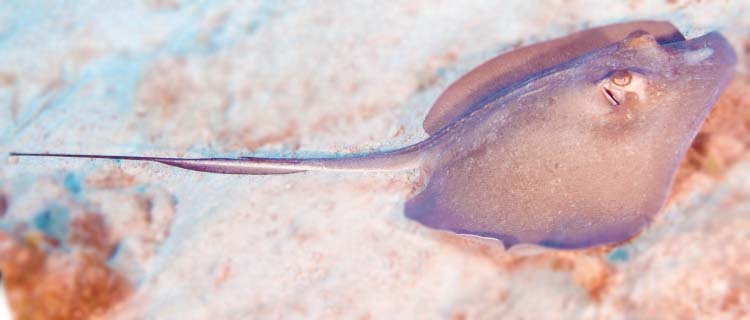
The Thornback Ray is a species of stingray from the Dasyatidae family. While this species is also observed in our Mediterranean and Black Sea regions, it should be included among the Aegean Sea fish species due to its higher prevalence there.
They don’t reside in very deep waters, but rather typically live around depths of 60 meters, particularly in muddy areas. Their primary diet consists of crustaceans found on the seabed. In addition, they also feed on mollusks, worms, and small fish.
Thornback Rays found in the Aegean Sea are typically around 40-45 cm in size or even smaller. Due to their barbed tails and spines, they are considered one of the more dangerous species for humans. They have no commercial value.
8. Brown meagre
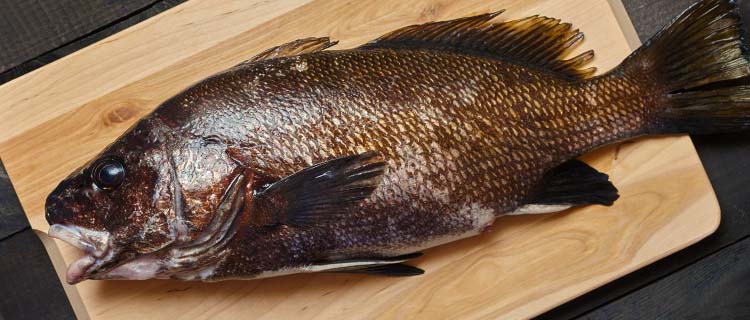
The Meagre is a marine fish species from the Sciaenidae family. This species, scientifically named Sciaena umbra, is found in our Mediterranean and Aegean Sea regions. The Meagre is a species commonly encountered by amateur fishermen.
Juvenile Meagres live near river mouths close to the coast, while adults live in depths ranging from 5 meters to 200 meters. The Meagre, which we included in our list of Aegean fish, can grow up to 60 cm in length, but they are generally observed to be around 30-40 cm in our country’s waters.
This fish has a unique feature. A stone, about 1 cm in diameter, can be extracted from the forehead area of the fish. Although not scientifically proven, it’s believed that when this stone is dissolved in lemon and consumed, it is beneficial for kidney stone ailments.
In terms of commercial value, it is considered of medium importance. It is a delicious species often served in fish restaurants
9. Blennioidei

The Blenny is a collective name for fish species from the Blenniidae family, which has around 900 sub-species living in both saltwater and freshwater (a small portion).
Under the name “Blenny”, there are 150 different genera and around 900 sub-species identified. A species known as freshwater blenny is occasionally kept in aquariums.
While these fish generally tend to be small, some variants resembling eels have been observed to grow up to 55 cm in length. They have large eyes and a mouth structure.
They spend most of their time on the seabed and in rocky crevices. They are not of commercial value and are among the fish of the Mediterranean and Aegean Seas.
10. Sparisoma cretense
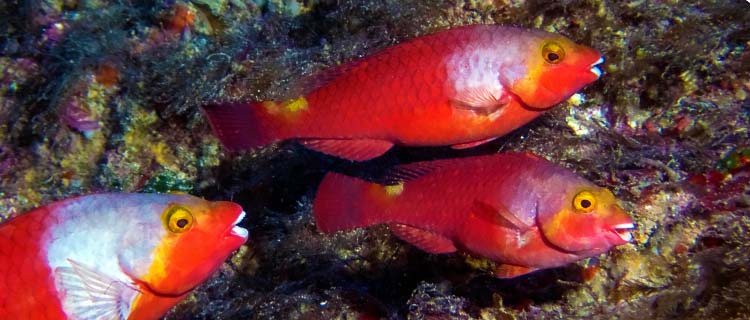
They generally live in seas with warm and temperate waters. The species, scientifically named Sparisoma cretense, belongs to the Scaridae family.
It is a brightly colored fish. Its appearance resembles a tropical version of the carp. The name “parrot” is given due to its mouth resembling a parrot’s beak.
While males have darker shades, females are in red-orange tones. They spend most of their time in coral reefs, feeding on seaweed there.
In their adult phase, they can grow up to 50 cm, but the ones in our country are around 20-30 cm. Iskaroz, which doesn’t have commercial value, has a medium taste.
11. Black scorpionfish
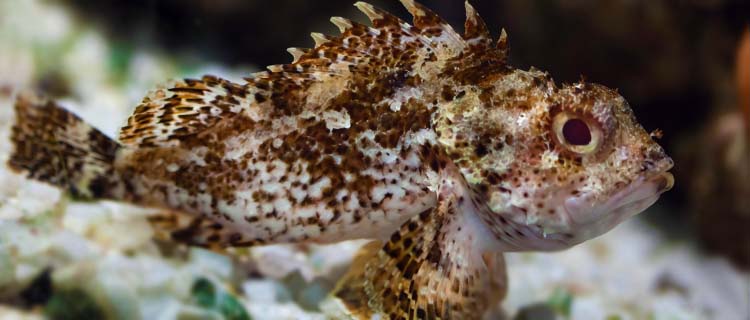
The Scorpionfish is one of the venomous species among the Aegean fishes. When touched, the spines on its fins poison the person, resulting in redness and swelling in the area.
This effect lasts for 2-3 days. It can be treated using ammonia. Especially among amateur fishermen, it is often mistaken for the swallow fish, leading to injuries. Care should be taken not to touch its spines when caught.
While the recorded maximum length is 37 cm, adults found in our waters are typically around 20-25 cm. It is one of the fish species found in the Mediterranean, Black Sea, and Aegean Sea.
Although the Scorpionfish is a venomous fish, it has delicious flesh and is packed with vitamins and fats that are highly beneficial to human health.
12. Annular seabream
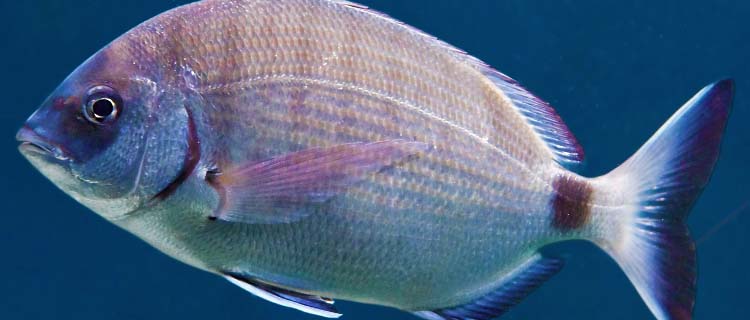
The fish known as “Annular seabream” belongs to the Sparidae family, and its scientific name is Diplodus annularis. This fish typically lives near temperate coastal regions. It is one of the Aegean Sea fishes and can also be found in our other seas.
They can reach a maximum length of 25 cm. In our waters, annular seabream are usually around 15-18 cm in length. It is a favored fish in sport fishing. The juveniles feed in lagoons during the winter. Shrimp, juvenile fish, and worms are their main diet.
Its commercial value is low, and they are primarily caught by rod and reel fishing. Its flesh is tasty and has few bones.
13. Spicara smaris
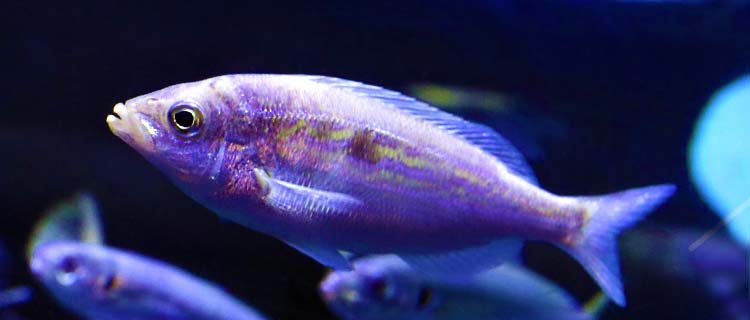
The “Spicara smaris” fish is found among the Aegean Sea fish species but is more commonly seen in our Mediterranean region. Scientifically known as Spicara smaris, belongs to the Sparidae family of sea fish.
They inhabit the rocky, muddy bottom parts of regions with warm waters. This species can reach up to a maximum size of 25 cm (in males), but they are generally observed to be around 15 cm in length in our waters.
There are two types of Spicara smaris living in our waters: Istargilos and Menekşe İzmarit. It is a delicious fish, typically cooked before being deboned.
14. Turbot
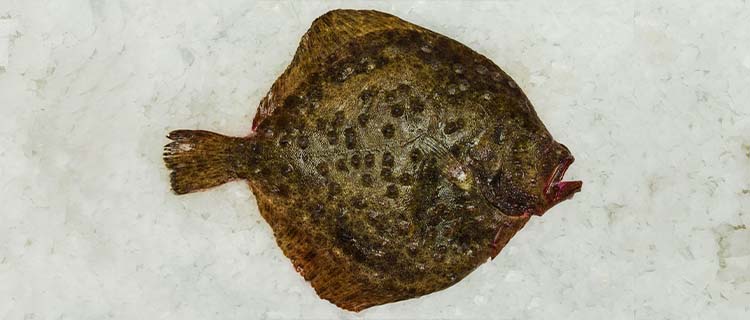
The turbot (Scophthalmus maximus) is a species of marine fish from the Scophthalmidae family, with both eyes located on the left side of its body. It uses the right side of its body to rest on the sea floor.
This species is found in all the seas surrounding our country. They typically inhabit depths ranging from 20 to 70 meters. Unlike typical fish, the turbot has a round body. They can grow up to a maximum length of 1 meter, but in our waters, adults are usually observed to be around 60-70 cm.
When they are still juveniles, their eyes are positioned separately on the left and right. However, as they grow and reach a size of about 8-10 cm, the right eye begins to migrate to the left side of the body.
Among the fish of the Aegean, the turbot has a high commercial value and is known for its delicious flesh.
15. Diplodus vulgaris

The Black Sea bream has a close relation to the Sea bream (often called Gilthead bream). It has several types such as Sarmos, mırmır, and sivri gaga.
It can grow up to a maximum length of 50 cm. In our country, it is found in the Mediterranean, Black Sea, and Aegean Sea regions. They are commonly seen at around 25 cm in these areas. They inhabit rocky and sandy areas.
In addition to its resemblance to the Gilthead bream in appearance, its taste is also similar. It is recommended to consume the Black Sea bream during cooler periods, as its flesh is fattier and more flavorful during these times.
16. Chub mackerel

The Chub mackerel, a member of the Scombridae family, is a marine fish that closely resembles the mackerel. The two can be differentiated by looking at their tail fins. The tail fin of the Chub mackerel is more pointed.
While the juveniles live near the shores in sandy areas and seaweed beds, adults tend to inhabit deeper waters further out at sea.
They live in schools. They can grow up to a maximum length of 50 cm, but the adults commonly found in our country’s waters average around 20-25 cm in length. It is among the delicious fish species of the Aegean Sea.
17. Common pandora
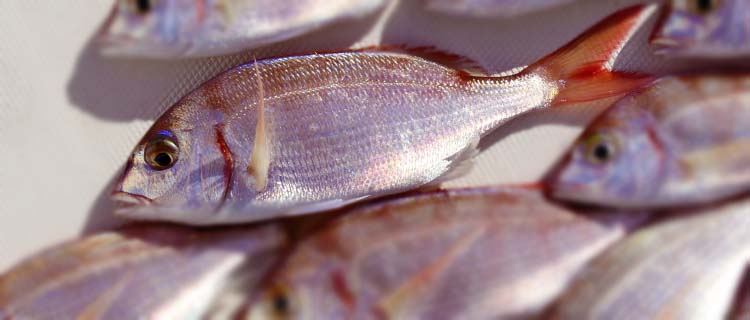
The Pandora (Pagellus erythrinus) is a member of the bream family, Sparidae, and is among the fish species found in the Mediterranean and Aegean Seas. It is a delicious fish that is widely consumed in Mediterranean countries.
The Pandora has a slender, oval-shaped body and can reach a maximum length of 50 cm, though they are commonly observed to be between 15-30 cm. This species is hermaphroditic, meaning they can change their sex.
Typically, they spend the early years of their life as females and switch to males in the later years. They are omnivorous, feeding mainly on small fish and invertebrates. In Mediterranean countries, the Pandora holds commercial value due to its tastiness.
18. White grouper
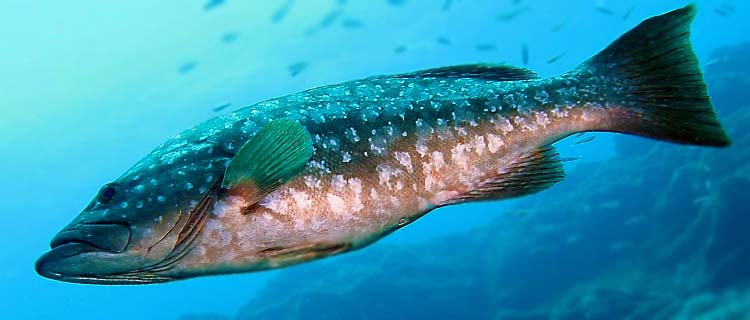
The White Grouper, also known as Lahoz, is a member of the Grouper family and is found in the Aegean and Mediterranean regions. It is among the larger fish species in the Aegean Sea. They can reach a maximum length of 125 cm and a weight of 25 kg.
Their habitats range from 20 to 250 meters in depth, consisting of rocky, gravelly, and stony areas. They are highly predatory carnivores, feeding on a variety of fish, invertebrates, and crustaceans.
The White Grouper is closely related to the Dusky Grouper, and its commercial value varies depending on the region. Especially in the Mediterranean area, it’s known for its delicious meat.
19.European seabass
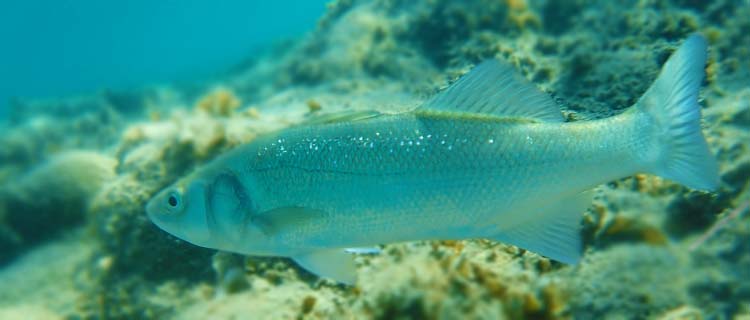
The Sea Bass, familiar to many of us, is a fish species from the Dicentrarchus family. Scientifically, it was first defined as Dicentrarchus labrax in 1758.
Although the largest recorded size to date is 1m in length and 12 kg in weight, they are commonly seen around 50 cm and weighing about 5 kg. It is known that they live in all our seas, primarily in the Mediterranean and Aegean.
Estuaries, lagoons, and places where rivers flow into the sea are their main habitats. It is also known that they occasionally venture into freshwater (excluding freshwater bass).
It is one of the Aegean Sea fish species with high commercial value, renowned for its tasty meat.
20. Scorpaena scrofa
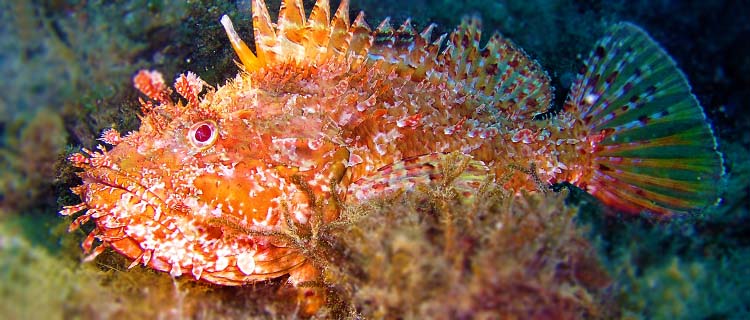
The Scorpaenidae fish, known as Lipsoz or Lipsos, resembles the Scorpionfish in appearance. The scientific name of this species is Scorpaena scrofa.
In our country’s waters, it is one of the species found in the Mediterranean and Aegean Seas, but it is not present in the Black Sea region. The species S. porcus can be found in the Black Sea region. Like the Scorpionfish, this fish is also poisonous.
Its body color can vary from terracotta tones to pinkish hues. It is known to reach a maximum length of 50 cm and a weight of 3 kg. However, the adult Lipsoz fish in our waters are generally around 25-30 cm.
It is one of the edible fish, and it’s most delicious when used in soups and steamed dishes.
21. Bluefish
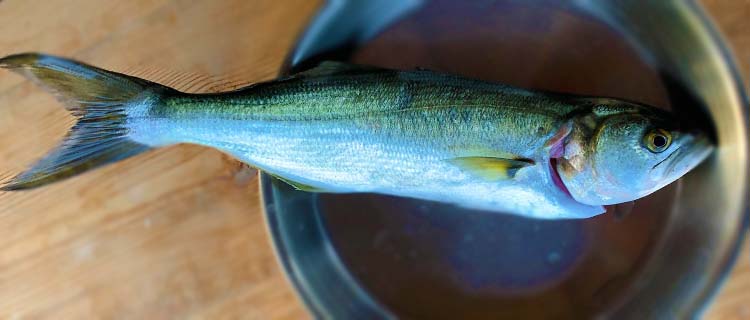
The Bluefish, belonging to the Pomatomidae family, is a fish of significant economic value and is highly flavorful among the Aegean fish species. Scientifically named Pomatomus saltatrix, the Bluefish is found in all the seas of our country.
Its maximum recorded size is 120 cm and 14 kg. The adult Bluefish in our region typically range from 30 to 60 cm. The Bluefish is a predatory marine fish that lives in loose and small groups.
The Bluefish has been given various names based on its size:
- Sarıkanat: Refers to the Bluefish juvenile ranging between 18 – 25 cm. It’s prohibited to catch or sell those below 18 cm.
- Lüfer: Once it reaches a size of 28 – 35 cm, it is referred to by this name. Catching and selling are permitted.
- Kofana: This name is given to Bluefish that are over 35 cm. Catching and selling are allowed.
- Sırtıkara: This refers to the Bluefish that are over 50 cm. It hasn’t been seen in our country’s waters for a long time. Catching and selling are permitted.
There was a period when the Bluefish was protected, making it illegal to catch or sell. However, today, this prohibition has been lifted, allowing those that are 18 cm and above to be caught and sold.
22. Spiny dogfish
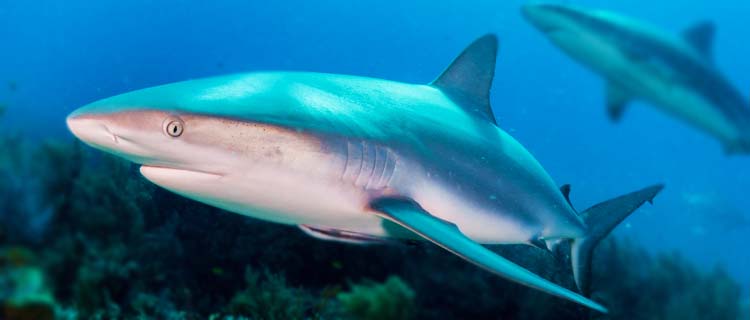
The Spiny dogfish, belonging to the Squalidae family, is found in our country’s waters, primarily in the Mediterranean and Aegean Seas. Although it’s not consumed in our country, it is known to be consumed in European countries.
Their primary diet consists of fish schools and octopuses. It’s known that this species can cause significant damage to the nets of professional fishermen. On rare occasions, they are caught by amateur fishermen who fish for bottom-dwelling species.
They have been observed to reach a maximum size of 150 cm and 10 kg, but they typically grow to around 80 cm and weigh about 4 kg. They have no commercial value.
23. Blackspot seabream
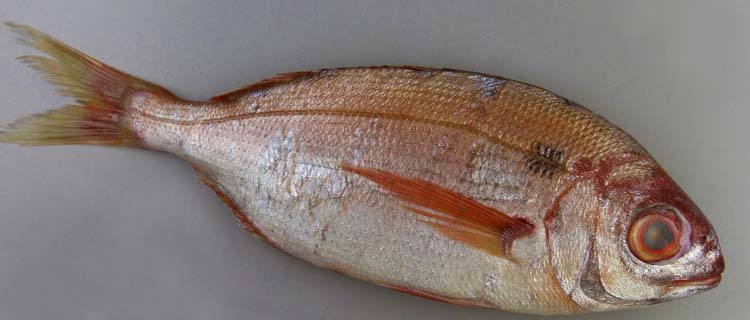
The Red Seabream, also known as the Blackspot Seabream (Pagellus bogaraveo), is a marine fish from the Sparidae family.
Primarily found in the Mediterranean, it prefers temperate and warm seas, making it one of the fish species of the Aegean region known for its mild temperatures. Depending on its habitat, it can descend to depths ranging from 400 to 700 meters.
The largest recorded size is 70 cm, but they are commonly found at around 30 cm and weigh about 4 kg. It has a tasty flesh, and grilling is the preferred method of cooking for this type of seabream.
24. Saddled seabream
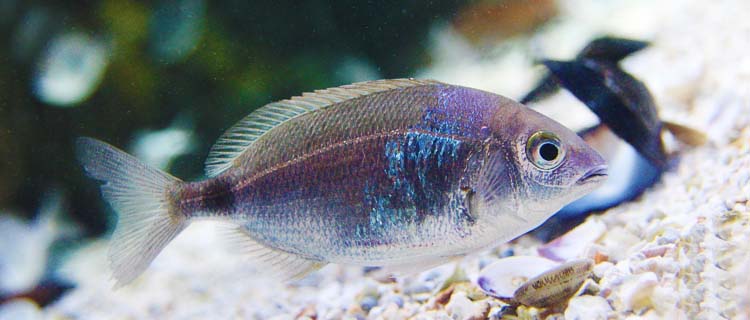
Melanur diğer adıyla Melanurya, Sparidae familyasından bir deniz türüdür. Ülkemizde Akdeniz, Marmara ve Ege bölgerinde bulunur. Bilimsel adı Oblada melanura olan melanur, Ege denizi balık türleri arasında yer alıyor.
Çok iri boyutlara ulaşabilen bir tür değildir. Kaydedilen maksimum boyutları, 38 cm ve 930 gr’dır. Ülkemiz sularında yaygın olarak 20 cm civarında görülürler. Hepçil olan türün ana besini omurgasızlardır.
Eti lezzetli türlerden biri olan melanurun ticari değeri orta seviyelerdedir.
25.Sturgeon
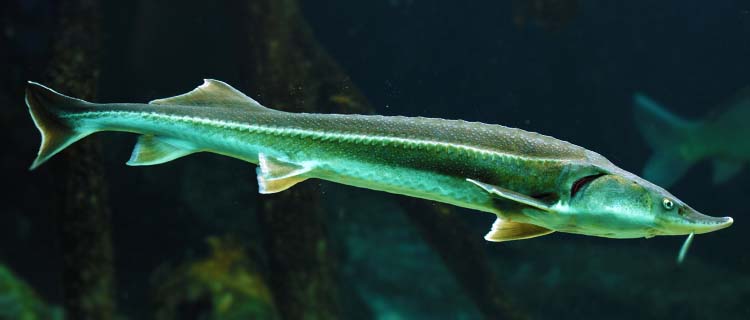
The name “Sturgeon” refers to several different species. There are 19 different species under the common name “Sturgeon.” They are differentiated by subtle variations in appearance. These fishes belong to the Acipenseridae family. While they are more commonly found in the Mediterranean region of our country, they are also present among the fish species of the Aegean Sea.
Their size varies depending on the species. Adult Sturgeon can typically range from 140 to 300 cm in length and weigh between 100 to 200 kg. The largest recorded dimensions are 7.2 meters in length and 1571 kilograms in weight.
The 18 different species under the name “Mersin fish” are as follows:
- Siberian Sturgeon
- Acipenser brevirostrum
- Yangtze Sturgeon
- Lake Sturgeon
- Russian Sturgeon
- Green Sturgeon
- Sakhalin Sturgeon
- Japanese Sturgeon
- Adriatic Sturgeon
- Fringebarbel Sturgeon
- Gulf sturgeon
- Atlantic sturgeon
- Persian sturgeon
- Sterlet, Sterlet Sturgeon
- Chinese Sturgeon
- Starry Sturgeon
- European Sea Sturgeon
- White Sturgeon
26. Cuttlefish

The squid is a mollusk species that belongs to the Cephalopoda class. It has a total of 10 arms, two of which are longer than the others, and these arms are lined with numerous suckers.
Squids are among the marine species of the Aegean Sea and prefer warmer waters. The size of this species varies significantly. Depending on the genus, they can range from 20 cm to a staggering 17 meters in length, though commonly, adult squids are between 50-60 cm.
They are commercially valuable, known for their tasty flesh.
27. Sand steenbras
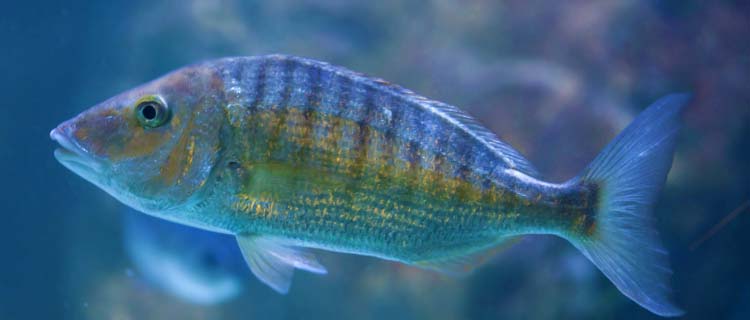
The fish known as ” Sand steenbras” belongs to the Sparidae family and is one of the economically valuable and delicious fish species. Sand steenbras , which live at the bottoms of the sea and in sandy areas, are frequently caught among the Aegean fish species.
In our country, they are commonly found in the Aegean, Mediterranean, and Marmara regions. Their main diet consists of crustaceans, worms, and mollusks.
They can reach a maximum length of 55 cm and a weight of 1 kg. However, their common size is around 30 cm. It’s one of the high commercial value fish species in the Aegean Sea.
28. Epinephelus marginatus

The fish known as “the dusky grouper” belongs to the Serranidae family and is also known by the name “yellowbelly grouper“. Its scientific name is Epinephelus marginatus. Dusky groupers are among the hermaphroditic (dual-sexed) marine fish.
The dusky grouper fish is endangered, which is why its fishing is prohibited. In our country, they live in the southern parts of the Mediterranean and Aegean seas.
They can reach a maximum size of 140 cm in length and weigh up to 60 kg, making them one of the large-sized fish in the Aegean region. The average size commonly observed in our country’s seas is around 60 cm in length and 15 kg in weight.
29. Orkinos

The Tuna, often seen in cans at supermarkets, belongs to the Mackerel (Scombridae) family. With various species under its collective name “Orkinos”, this fish is one of the largest in the seas.
It’s among the largest species of fish in the Aegean Sea. An adult tuna can reach lengths of up to 6 meters and weigh as much as 1 ton. However, the likelihood of finding a tuna of this size is very low; they are typically caught at sizes between 3-4 meters and weighing 400-600 kg.
Tuna has a very high economic value and is an extremely delicious fish.
30. European flounder

European flounder can be confused with the Turbot, but by looking at their pictures, they can be easily distinguished. European flounder, belonging to the Pleuronectidae family, has a more elliptical body shape compared to the Turbot, and it lacks the bony structures referred to as “buttons” on the Turbot’s back.
Additionally, the eyes of the Plaice are on the right side of its body. The largest recorded size is 60 cm, but they are commonly around 30 cm in length.
In our country, they can be found in the Mediterranean, Aegean, Black Sea, and Marmara regions.
31. European pilchard
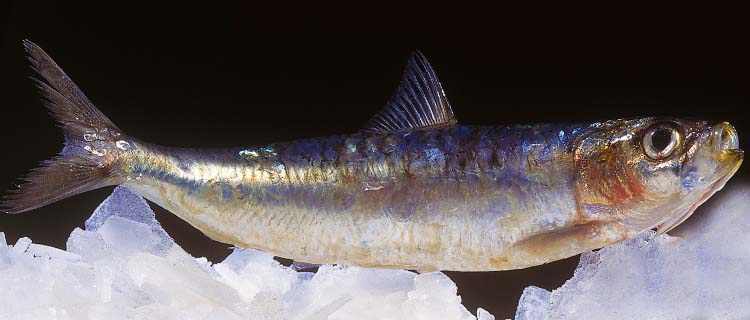
The European pilchard is closely related to the Anchovy and is a fish species from the Clupeinae family. They live by migrating in schools, often close to the shore.
While European pilchards are more commonly found in the Mediterranean and Black Sea, they are also among the fish species of the Aegean Sea. In our seas, they reach sizes of 15-20 cm, but sardines in oceanic regions can grow up to 30 cm in length.
They are of high commercial value and are considered a tasty fish species.
32. Garfish
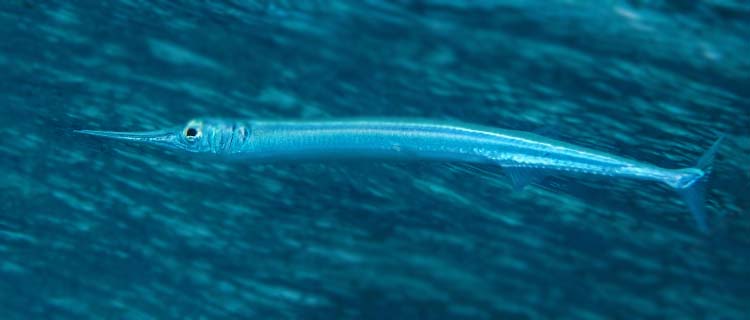
The Garfish (Belone belone), which deviates from the typical fish appearance with its long and slender body, is a member of the Belonidae family. Thanks to their body structure, they are fast and agile swimmers.
Depending on the region they inhabit, they can reach lengths of up to 1 meter. However, in our Mediterranean and Aegean seas, they grow up to about 60 cm.
Their primary diet consists of small fish, and they feed on species like anchovies. They have high commercial value and are considered a delicious fish in the Mediterranean and Aegean regions.
33. Sargo

The White Seabream, commonly known as Sargoz in the Mediterranean and Aegean regions, is often confused with Karagöz. Its scientific name is Diplodus sargus and it belongs to the Sparidae family of sea fish.
This fish is known by different names depending on the region. It’s also referred to as Baltabaş, Sargos, and Ak Karagöz. It is prevalent in the Mediterranean and Aegean regions of Turkey.
They have a strong jaw and their primary diet consists of crustaceans, mollusks, and seaweeds. It’s a fish with high economic value and is known for its delicious taste.
34. Common dentex
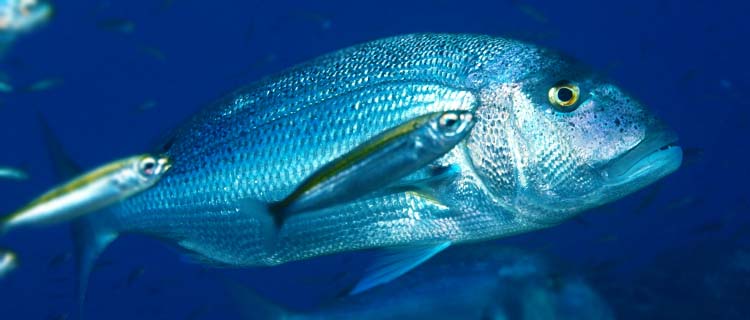
Belonging to the Sparidae family, the Common Dentex is scientifically named Dentex. While it’s prevalent in the Mediterranean, it can also be found among the fish of the Black Sea, Marmara, and Aegean regions.
They inhabit rocky and sandy areas, living at depths of up to 200 meters. Their primary diet consists of cephalopods and mollusks. They generally lead solitary lives but can be seen in small schools during the breeding season.
They can reach lengths of up to 1 meter and weigh up to 20 kg. Angling for them is highly enjoyable, and they are known for their delicious meat, although they are not commonly found.
35. Striped red mullet
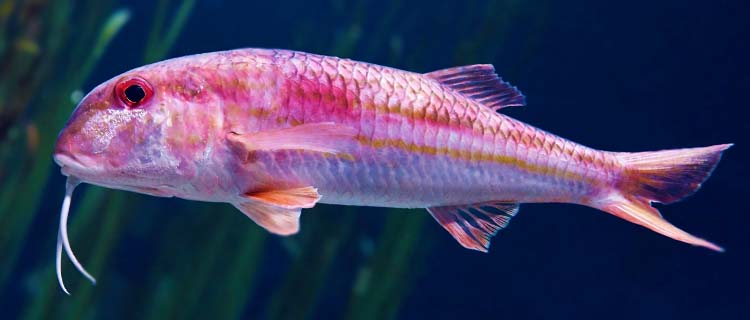
The Striped Red Mullet, scientifically named Mullus surmuletus, is a marine fish from the Mullidae family. It can be found among the fish species of the Mediterranean, Black Sea, and Aegean Sea.
They inhabit areas ranging from shallow waters of 5 meters deep to depths of up to 400 meters. The recorded maximum size is 40 cm and 1 kg, but they are commonly seen at around 25 cm in our waters. It has commercial value and is also used as a baitfish.
36. Greater weever
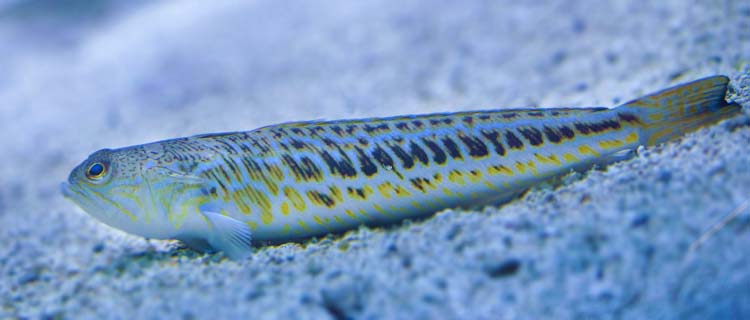
The Greater Weever, commonly referred to as the dragon fish among locals, belongs to the Trachinidae family and its scientific name is Trachinus draco.
This fish is equipped with venomous spines and releases a toxic substance when touched. It’s among the venomous fish of the Aegean Sea. Its venom is potent, capable of causing limb loss or even a heart attack.
It lives in sandy or pebbly areas between depths of 1 meter and 150 meters. Its main diet consists of small fish, invertebrates, and crustaceans. The Greater Weever can grow up to 55 cm, but they are typically seen around 25 cm. It holds no commercial value.
37. Bluespotted seabream
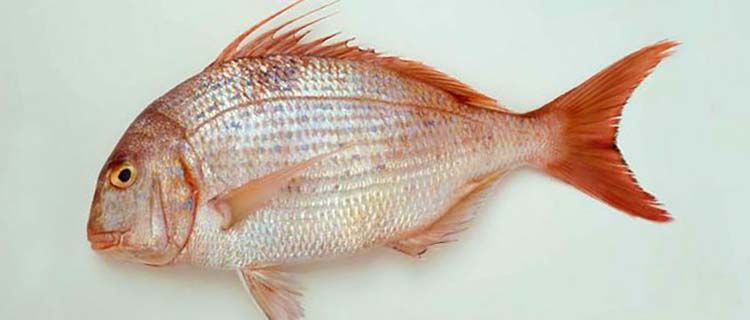
The Bluespotted Seabream is one of the famous species among Aegean fish. In the region, it is also known by names such as Çavuş, Antenli Mercan, and Altınkaş. Its scientific name is Pagrus caeruleostictus, and it belongs to the seabream family.
This large fish thrives in shallow and warm waters and usually lives solitarily. It is carnivorous, with cephalopods and small fish being its primary food sources. The Bluespotted Seabream is known to migrate constantly to oceans and different seas.
Adult sizes typically range between 60-75 cm, but they can grow beyond 1 meter. It is of high economic value and is considered a tasty fish.
38. Atlantic saury
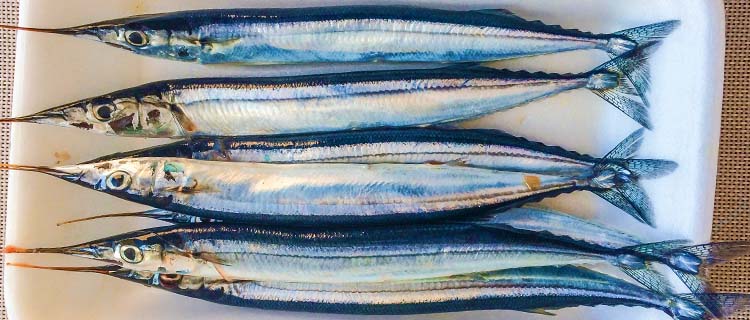
The Atlantic Saury, known as Zurna Balığı in Turkish and scientifically referred to as Scomberesox saurus, belongs to the Scomberesocidae family of marine fish. Inhabiting the open seas, this species was spotted in the Mediterranean and Aegean seas following the opening of the Suez Canal.
Its maximum length is about 50 cm, but it typically measures around 35 cm. The Atlantic Saury feeds on fish larvae and plankton. As they are not typically fished, they don’t hold any significant commercial value.
In this guide, we introduced you to the fish of the Aegean Sea. The Aegean Sea, home to approximately 10,000 different species, boasts a rich diversity of marine life. We briefly described some of the species found in our waters.
We hope you enjoyed our list consisting of 38 different species, including some venomous ones. Of course, there are many other well-known fish species that are not included in this list.
Please feel free to leave comments with all your questions and feedback.
FAQs
How Many Types of Fish are there in the Aegean Sea?
The Aegean Sea, which is home to a total of 10,000 different marine species, has around 300 types of fish, of which about 100 have commercial importance.
Do Octopuses Live in the Aegean?
Yes, octopus species inhabit the Aegean Sea. They typically live among rocks in shallow areas.
Are There Sharks in the Aegean Sea?
There are approximately 36 different shark species living in the Aegean Sea. One of them is the Spiny dogfish shark, which we mentioned in our article.
Kaynaklar: Wikipedia

